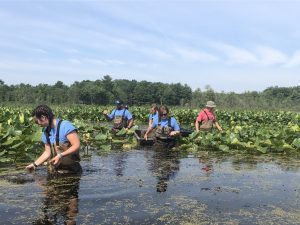By Nate Beard, Boat Steward
COVID-19 has introduced some challenges for WNY PRISM’s Watercraft Inspection Steward Program with regards to stewards being able to safely communicate with boaters, but through taking the necessary precautions we have been able to continue business almost as usual. A positive side effect of the pandemic is that more people have been taking time to get outside and enjoy nature. At the beginning of the season there were many people who- were launching their new boats, jet skis, kayaks and paddle boards for the first time ever. Many of these first-time boat owners had never heard of aquatic invasive species (AIS) before, so this opened up the chance to have a productive conversation that introduced the boater to the issues and how they could Clean, Drain, and Dry to help.
My day starts at about 5:30am, so that I can wake up, eat, and get to my launch at Bemus Point on Chautauqua Lake by 7am. The first thing I do at the launch is to count how many trailers are in the parking lot to get an idea of how many boats have already launched. Often I can recognize the car and trailer as one of the regulars that launch at Bemus Point, and this gives me some ease of mind, as they regularly clean, drain, and dry their boats if they take them elsewhere. Some of them even power-wash and clean their boats every night despite them being launched only on Chautauqua. One boater told me he only launches his boat if it’s clean enough to eat off.
There is usually a steady flow of boats throughout the day, but some days when there is a fishing tournament (bass or muskie) the launch will get packed and there will be 10-20 boats launching back-to-back. This makes me glad that I also work with two other stewards from the Chautauqua Lake Association so that we can divide up the boats. It’s important for our work that we miss as few boats, launching or retrieving, as possible.

Checking boats for aquatic invasive species (AIS).
Getting to talk to boaters is one of the best parts of the job! Sometimes it is as simple as introducing them to the topic of AIS prevention, but other times the boaters are well versed in the subject, and this usually leads to interesting conversations. I’ll have many different kinds of conversations throughout the day with boaters as I do inspections. I’ve found that people are much more willing to listen and take the time for an inspection if there is an active conversation occurring. Sometimes it’s just about how the fishing was, or if they had a good time out on the water.
There’s also some Bemus residents that will go on daily walks, and they’ll stop and talk with me, asking about how the lake is doing, how many weeds there are, what they can do to help despite not having boats, etc., but almost all of the conversations end with a genuine “thank you.”
Most days I’ll be at Bemus Point doing inspections, but WNY PRISM also provides occasional opportunities for AIS management. One example of this was the water chestnut (Trapa natans) pull that we assisted the Audubon Community Nature Center with. Several stewards from the WNY PRISM program met up and we learned how to identify water chestnut, as well as the best way to safely remove it. The nutlets at the base of the plant’s stem have four large, sharp spikes, and if you weren’t careful as you pulled the plant out, you could end up with a nasty cut. It’s important to be sure to pull the nutlets though, as they are what allow water chestnut to maintain a population. The nutlets can be viable in the sediment for up to 10 years! To pull the weed, we all put on rubber waders and had floating sleds that we would put the pulled plants onto. It was an educational experience, both about water chestnut and the ecosystem of large ponds and wetlands.

WNY PRISM boat stewards remove water chestnut (Trapa natans) alongside Audubon Community Nature Center.

Floating sled with pulled water chestnut (Trapa natans).

